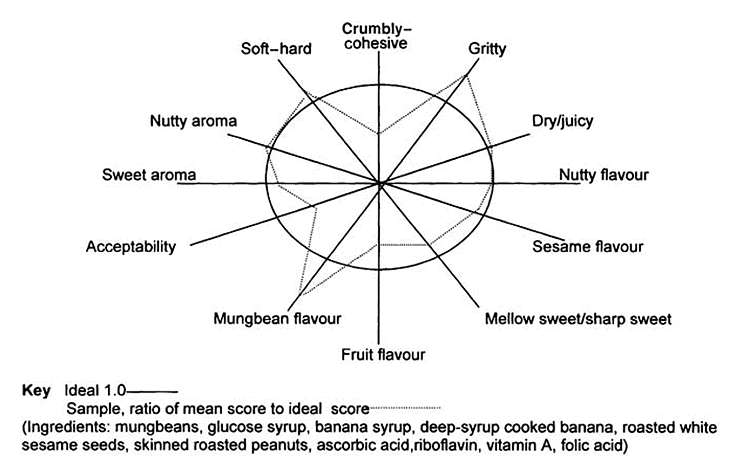FOOD
PRODUCT DEVELOPMENT
Mary Earle, Richard Earle and Allan Anderson |
| Loading
|
|
||||
|
|
Part
2, Chapter 5
The consumer in product development 5.7.3 Ball park experiments In many studies it is important to relate the characteristics of the raw materials to the final product qualities so that in product formulations, raw materials can be varied to achieve the optimum product. For example the sensory properties of the raw materials can be related to the sensory properties of the products which in turn are directly related to the consumer acceptance of the final product. The sensory properties of each available raw material and its competitive and compensatory actions need to be identified either from recorded information or from experimental work. A linear function can then be used, within a linear programming model, to select subsets of raw materials, which can be combined through processing to have attributes acceptable to the consumer (Chittaporn, 1977).
Moskowitz (1994) showed how products can be built up and optimised by studying the effects of ingredients in the acceptance of the product prototypes; sometimes the relationships between the formula ingredients and the sensory attribute ratings are non-linear, and there are interactions occurring, so that the relationships can be complex. During the preliminary design and process development, a wide range of ingredients may be screened and the processing and cost limits are identified. Product testing at this stage is better done internally (Wilton and Greenhoff, 1988), but once the limits of the design are identified and optimisation of the product quality starts, it is useful to bring in consumer testing. Sometimes internal development is completed before consumer testing is started, but this may lead to recycling of the design and accompanying delays. If factorial experiments or mixture designs are used to follow changes in processing variables and proportions of ingredients, then consumers can test the products and not only show how overall acceptance varies but also how critical product attributes change (Schutz, 1993). From their responses can be predicted the optimum area for further development. By regression of the results from the factorial experiment, an equation relating acceptability scores or ratios of attribute scores to the ideal product, to the ingredient and processing variables is obtained, which can be used to predict the optimum processing point. If this is a linear relationship, it can be used in linear programming with other factors such as nutritional compositions and costs. An alternative method is to use expert optimisation where the consumer sets their ideal points on the product characteristics in the product design specifications and then a small group of trained panellists can follow the changes of the specific product attributes and relate these to the consumer ideals. Physical tests can be used which are corrrelated with the consumer measure- ments of a product. Use of trained panellists quickens the design and develop- ment. Care must be taken to bring in the consumers when the prototype products are nearing the optimum to check if the ideals are still related to acceptance by the consumer and that no rogue characteristics have crept in which are not wanted by the consumers. In developing a nutritionally balanced snack product for urban Thai children, Sinthavalai (1986) developed a formulation by linear programming based on nutritional needs and costs, and developed some preliminary product prototypes by interacting expert sensory testing with the linear programming choice of ingredient levels. A consumer panel tested the final prototype from this experimentation. The magnitudes of the attributes and also the ideal scores for each attribute were recorded. The ratios of the experimental scores to the ideal score (1.0) are shown in Fig. 5.13.  Fig. 5.13 Thai snack bar profile, ratio to ideal by small consumer panel (Source: From Sinthavalai, 1986). (- click to enlarge) It was found, shown by the distance from the ideal, that the prototype was rather crumbly and gritty, and had a rather strong mungbean flavour and weak fruit flavour. Crumbliness in particular was not ideal. This initial prototype set the direction for further experimentation in processing and raw materials, these new prototypes being tested by large panels of Thai children. |
|
 |